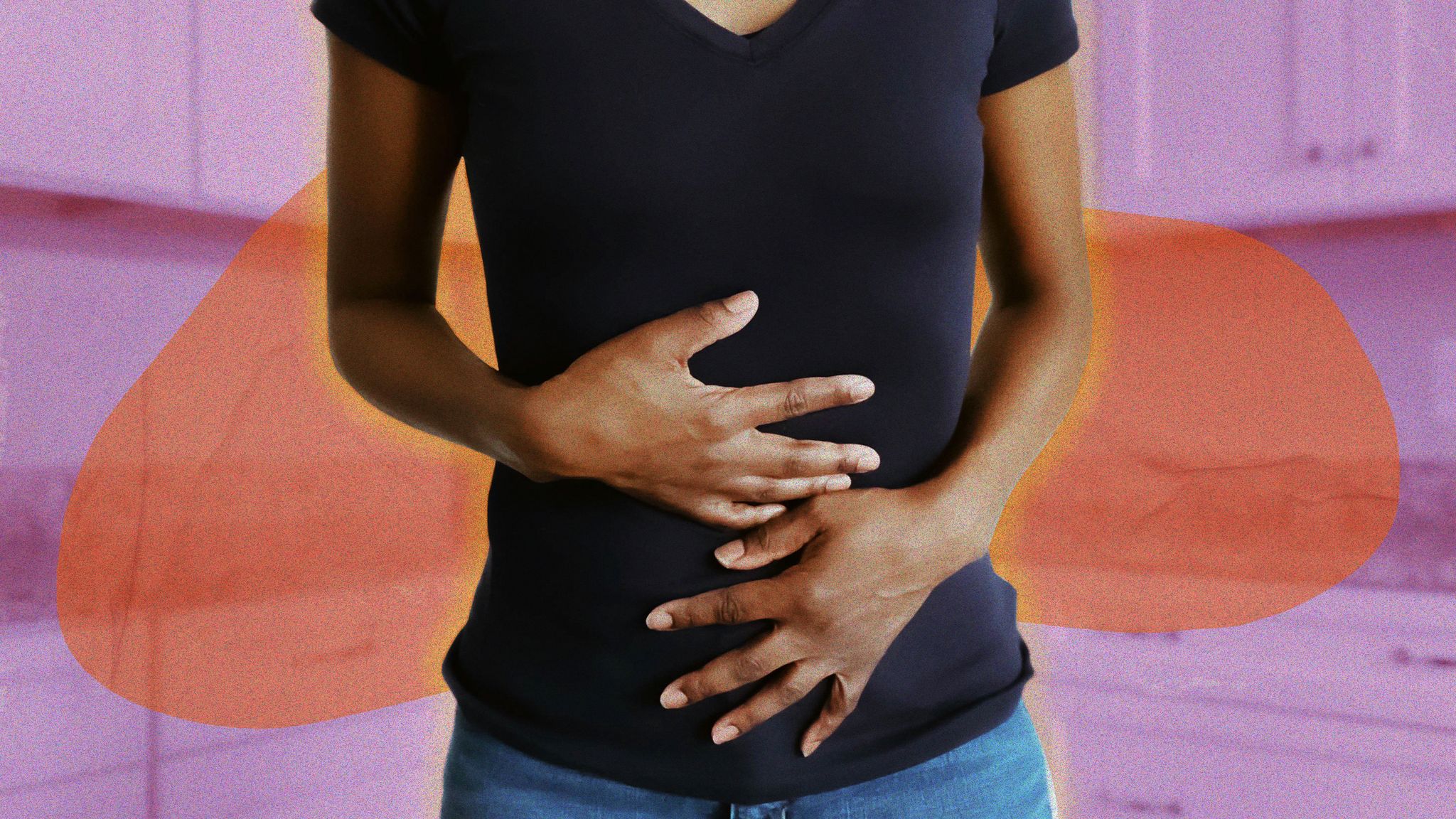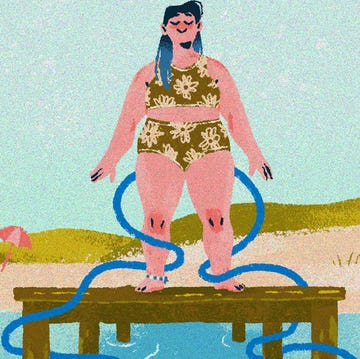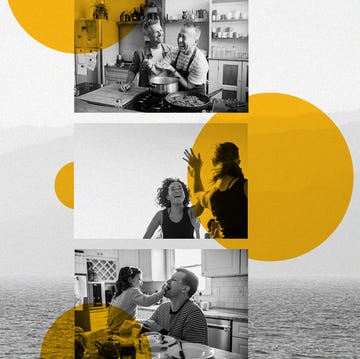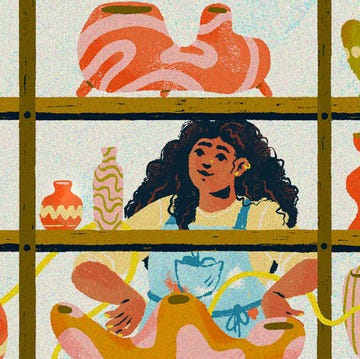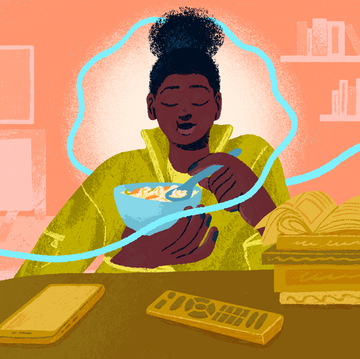I was lying on the couch for yet another week, unable to work, feeling brain fog, nausea, a loss of appetite, bloating, and constant cramps. I could barely move. The pain crept up on me. This sensation had been exponentially increasing over the span of a few years. There was heavier and heavier bleeding, more and more cramping — not just during my periods, but between them.
Why wasn’t I aware that fibroids could totally knock me out from living my life? The story we're typically told goes something like this: Fibroids sometimes happen inside the uterus. They are harmless, noncancerous tumors. You’re supposed to leave them alone and forget about them. They only need to be removed if they truly become a problem. And the most inexpensive way to deal with them is to just wait until menopause, when they shrink on their own.
My fibroids became a problem I couldn’t ignore when an ultrasound revealed one was sitting on my bladder, with another on my bowel. I was in agony. It felt like labor pains, only there was no baby on the way. The recovery after I had my fibroids removed was on par with how I felt during childbirth with 36 hours of labor and an emergency C-section. For the first few weeks, I could barely walk. I couldn’t get back on my bike for two months.
My doctors said I didn’t qualify for the less intense keyhole surgery or uterine fibroid embolization, which shrinks the fibroids, because mine were already too big. The largest measured 3-by-2-and-a-half inches. I could have undergone a total hysterectomy but chose a myomectomy, where the fibroids are cut out instead. Doctors offer a choice because — and this is the brutal part — fibroids can grow back.
It’s understandable why most women in my situation opt for a hysterectomy. Why risk a lifetime of pain? But I wanted to keep my reproductive system — not because I necessarily want to have more children, but because it’s mine. The doctors assure that you’ll be fine after a hysterectomy, that it won’t affect your hormones too much. But who knows how your body is going to react? Every body is different.
I’d already endured enough drama in that region after an IUD led to pelvic inflammatory disease, resulting in permanent chronic health problems. Nowadays, the pill and IUDs are regularly marketed not merely as contraceptives but also as remedies to reduce painful and heavy periods caused by endometriosis or fibroids. But with research linking fibroid growth to hormone imbalance, there doesn’t seem to be definitive evidence proving that hormonal contraceptives don’t contribute to fibroid growth.
Before the pain completely incapacitated me, I ended up in the hospital on two separate occasions because I was bleeding so much. Clots as big as my fists. Ultrasounds were ordered, and I was referred back to my gynecologist. The approach was always the same: Take tablets to slow the flow of blood, hope menopause will kick in soon, and maybe consider endometrial ablation, a procedure that removes a layer of the uterus to stop heavy menstrual bleeding.
The lack of any deeper explanation from my doctors made me feel hopeless. No medical professional I saw told me that I might consider removing my fibroids before they grow larger and might require an invasive surgery. I received no recommendations on lifestyle changes that might help. I was never informed how truly terrible the experience could be for my body — or mind.
For a long time, I was super-depressed and anxious. I now know that low iron from my repeated blood loss wasn’t the only contributor to my fatigued brain. If fibroids grow in environments of hormone imbalance, that can also affect your mental health. After my fibroid recovery, my overall quality of life, including my mental health, improved. It would have been nice to have been prepared for this excruciating journey.
There’s little hope on the internet, where few answers and vague information provide no comfort. For instance, according to the Office on Women’s Health, about 20 percent to 80 percent of women develop fibroids by the time they reach 50. That’s an awfully large range. Johns Hopkins Medicine states fibroids are harmless 99 percent of the time. Harmless? I must be in the 1 percent because if I can’t look after my child or work, I would classify that as harmful.
A 2014 study of ultrasound evidence found that more than 80 percent of Black women and approximately 70 percent of white women will have uterine fibroids by 50. However, because only 20 to 50 percent of women with fibroids experience symptoms, and because fibroid screenings are not routinely performed, the true incidence rate is unclear. Black women tend to suffer at a younger age and more severely than white women. Another study suggests that childhood abuse, known to trigger stress and hormone imbalances, could contribute to the risk of developing fibroids.
We need much more fibroid research as well as education to help guide women through this confusing and painful medical issue. According to the Society for Women’s Health Research, fibroid research received about $17 million in funding from the National Institutes of Health, putting it in the bottom 50 of 292 funded conditions in 2019. By comparison, that same year, there were five times more studies of erectile dysfunction than of premenstrual syndrome.
Organizations such as The Fibroid Foundation are diligently working to raise awareness and act as a community hub and resource for fibroid patients. It recently led efforts to introduce the Stephanie Tubbs Jones Uterine Fibroid Research and Education Act to provide $150 million to the National Institutes of Health.
But even if the bill is passed by Congress, according to Fibroid Foundation founder and CEO Sateria Venable, it’s not enough. “Uterine fibroids are the most frequently diagnosed uterine growth in women,” she says. “It is grossly underfunded given the 26 million U.S. women affected, and millions of women worldwide affected.”
Some preliminary research suggests that diet and exercise could play a key role in the prevention and management of fibroids. If women from a young age knew what they could do to help prevent fibroids, we might see less fibroid surgeries and hysterectomies in the future. After my experience, that would be a very good thing. In the meantime, I’m living my best life, but there’s always that fear at the back of my mind that my uterus is a ticking time bomb. I pray to the universe my fibroids don’t grow to an unbearable size before I hit menopause.
Koraly Dimitriadis is a poet, writer, performer, and author of Just Give Me the Pills and Love & F--k Poems. Follow her on Twitter at @koralyd.
Get Shondaland directly in your inbox: SUBSCRIBE TODAY
